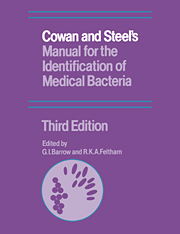Book contents
- Frontmatter
- Contents
- Foreword
- Preface to the first edition
- Postscript
- Preface to the second edition
- Preface to the third edition
- List of contributors
- Introduction
- 1 Classification and nomenclature
- 2 Culture media: constituents and sterilization
- 3 Principles of isolation
- 4 Bacterial characters and characterization
- 5 Theory and practice of bacterial identification
- 6 Characters of Gram-positive bacteria
- 7 Characters of Gram-negative bacteria
- 8 Taxonomy in theory and practice
- 9 Bacterial identification by cards
- 10 Bacterial identification by computer
- 11 Quality control in microbiology
- Appendices
- References
- Index
3 - Principles of isolation
Published online by Cambridge University Press: 15 December 2009
- Frontmatter
- Contents
- Foreword
- Preface to the first edition
- Postscript
- Preface to the second edition
- Preface to the third edition
- List of contributors
- Introduction
- 1 Classification and nomenclature
- 2 Culture media: constituents and sterilization
- 3 Principles of isolation
- 4 Bacterial characters and characterization
- 5 Theory and practice of bacterial identification
- 6 Characters of Gram-positive bacteria
- 7 Characters of Gram-negative bacteria
- 8 Taxonomy in theory and practice
- 9 Bacterial identification by cards
- 10 Bacterial identification by computer
- 11 Quality control in microbiology
- Appendices
- References
- Index
Summary
Isolation methods
Isolation begins with the collection of the specimen. Normally the clinician takes the specimen and sends it to the laboratory, but there are occasions when the bacteriologist should go to the patient or vice versa, so that fresh material can be examined while ‘hot’.
Direct microscopy. Since amoebic and bacillary dysentery cannot be distinguished clinically, it is essential when amoebic dysentery is endemic or is suspected, to examine a freshly passed stool on a warmed microscope stage to see the characteristic movements of vegetative Entamoeba histolytica; even better specimens may be obtained at sigmoidoscopy. Only by seeing the movement of E. histolytica can it be distinguished from Entamoeba coli; the differences between the encysted forms are not sufficiently great or constant to be diagnostic. The serous fluid of a primary chancre collected in a capillary tube can also be examined unstained by microscopy for spirochaetes. Stained material from leprosy lesions usually shows abundant organisms which, as yet, defy the usual cultural methods.
It is usually unrewarding to stain blood films for bacteria, but in hot countries bacteria are not the only causes of fever; malaria parasites and other bloodborne protozoa should therefore always be sought. Pus, cerebrospinal fluid (centrifuged deposit), pleural effusions, and other transudates may show bacteria or other microorganisms when stained by Gram's method; if none is seen, a film stained by the Ziehl–Neelsen (ZN) method may reveal acid-fast rods.
- Type
- Chapter
- Information
- Publisher: Cambridge University PressPrint publication year: 1993



